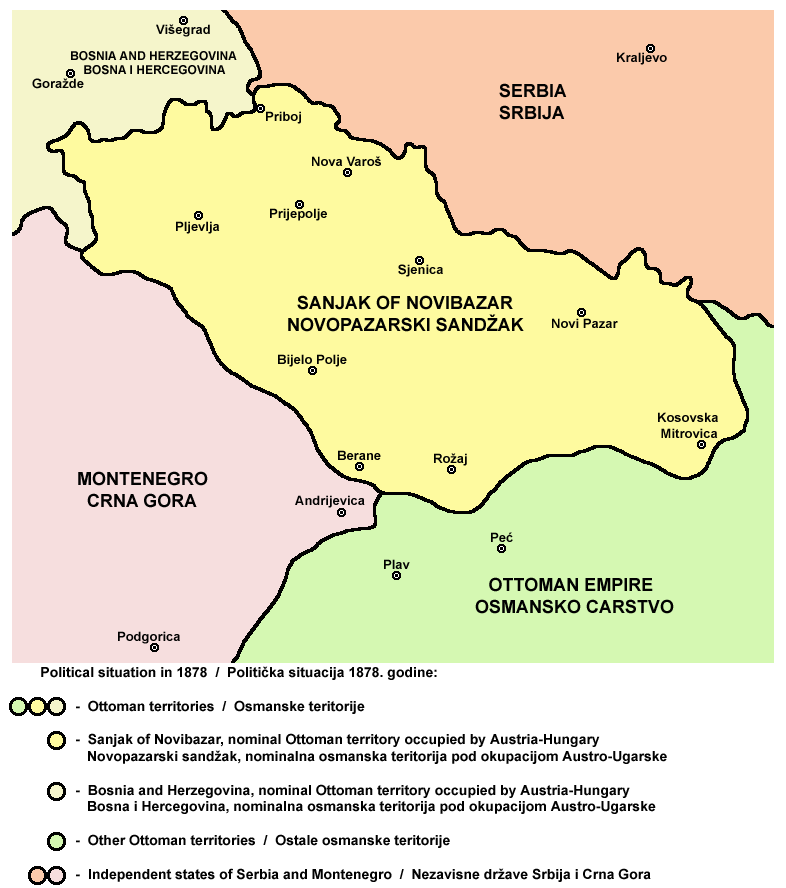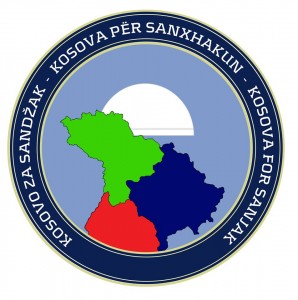The Sanjak of Novi Pazar (Bosnian and Serbian: Novopazarski sandžak/Новопазарски санџак; Turkish: Yeni Pazar sancağı) was anOttoman sanjak (second-level administrative unit) that existed at times from 1864 until the Balkan Wars of 1912–13 in the territory of present-day Montenegro, Serbia and Kosovo. Today, the region is known as Raška and Sandžak.
Following the promulgation of the Vilayet Law in 1864, and the dismantling of the Bosnian Eyalet, Novi Pazar became a stand-alone Sanjak with its administrative seat in the city of Novi Pazar prior to becoming a part of the newly established Kosovo Vilayet in 1878. Throughout its existence it included most of the present day Sandžak region (named after the Sanjak of Novi Pazar), also called Raška, as well as northern parts of Kosovo (area around Kosovska Mitrovica).
Congress of Berlin (1878)
At the Congress of Berlin in 1878, the Austro-Hungarian Foreign Minister Andrássy, in addition to the Austro-Hungarian occupation of Bosnia and Herzegovina, also obtained the right to station garrisons in the Sanjak of Novi Pazar, which remained under Ottoman administration. The Sanjak preserved the separation of Serbia and Montenegro, and the Austro-Hungarian garrisons there would open the way for a dash to Salonika that “would bring the western half of the Balkans under permanent Austrian influence.” “High [Austro-Hungarian] military authorities desired [an …] immediate major expedition with Salonika as its objective.”
On 28 September 1878 the Finance Minister, Koloman von Zell, threatened to resign if the army, behind which stood the Archduke Albert, were allowed to advance to Salonika. In the session of the Hungarian Parliament of 5 November 1878 the Opposition proposed that the Foreign Minister should be impeached for violating the constitution by his policy during the Near East Crisis and by the occupation of Bosnia-Herzegovina. The motion was lost by 179 to 95. By the Opposition rank and file the gravest accusations were raised against Andrassy.
On 10 October 1878 the French diplomat Melchior de Vogüé described the situation as follows:
Particularly in Hungary the dissatisfaction caused by this “adventure” has reached the gravest proportions, prompted by that strong conservative instinct which animates the Magyar race and is the secret of its destinies. This vigorous and exclusive instinct explains the historical phenomenon of an isolated group, small in numbers yet dominating a country inhabited by a majority of peoples of different races and conflicting aspirations, and playing a role in European affairs out of all proportions to its numerical importance or intellectual culture. This instinct is to-day awakened and gives warning that it feels the occupation of Bosnia-Herzegovina to be a menace which, by introducing fresh Slav elements into the Hungarian political organism and providing a wider field and further recruitment of the Croat opposition, would upset the unstable equilibrium in which the Magyar domination is poised.
This Austro-Hungarian expansion southward at the expense of the Ottoman Empire was designed to prevent the extension of Russianinfluence and the union of Serbia and Montenegro.
Ottoman administrative changes
In order to stop the Austro-Hungarian influence in the western parts of the Raška region, the Ottoman government made a new administrative change: the Sanjak of Novi Pazar was removed from the Bosnia Vilayet (with seat in Sarajevo) and joined into the Kosovo Vilayet (established in January 30, 1877, with seat in Priština) in 1879.[8][9] In 1880, the Sanjak of Pljevlja was established, which included the kaza (districts) of Pljevlja (its seat), Prijepolje, and the mundirate (branch office) in Priboj; these were places where Austro-Hungarian garrisons were located. In 1902, the Sanjak of Sjenica was established, which included the districts of Sjenica (its seat), Nova Varoš,Bijelo Polje and Lower Kolašin (part of modern Bijelo Polje and Mojkovac municipalities).

Withdrawal of Austro-Hungarian garrisons in 1908
At the beginning of 1908, Austria-Hungary announced intentions to build a railway through the Sanjak towards Ottoman Macedonia, which caused an international uproar. However, in negotiations with Russia the Austro-Hungarians indicated they would be willing to vacate the Sanjak in exchange for recognition of the annexation of Bosnia-Herzegovina. The Austro-Hungarian garrisons were withdrawn from the Sanjak of Novi Pazar in 1908, following Austria-Hungary’s formal annexation of the neighboring Ottoman vilayet of Bosnia, which also belonged (de jure) to the Ottoman Empire until 1908, but was under Austro-Hungarian military occupation since theTreaty of Berlin in 1878.
Balkan Wars (1912–1913) and the end of Ottoman rule
In the aftermath of the Ottoman defeat during the First Balkan War of 1912–1913, the territory of the Ottoman Sanjak of Novi Pazar was divided between Serbia and Montenegro at the Treaty of London in 1913.
Population
The Sanjak of Novi Pazar was mainly populated by Slavic-speaking Muslims (Islamized South Slavs, Bosniaks), Serbs (Orthodox Christians), Albanian Muslims and Turks.
